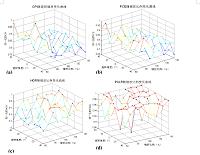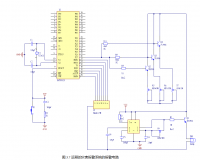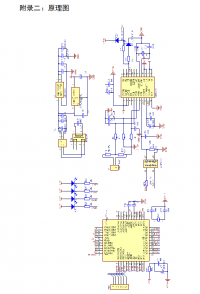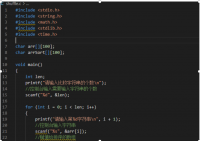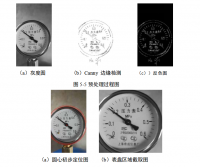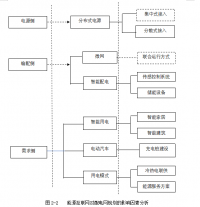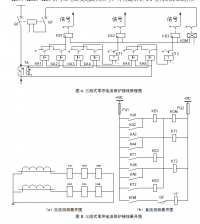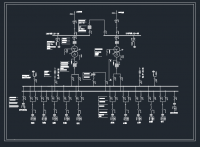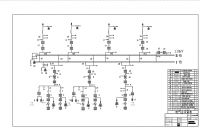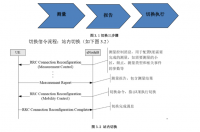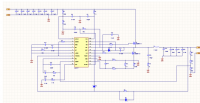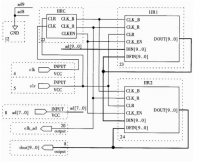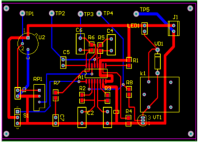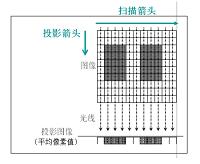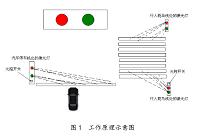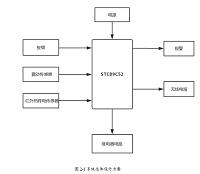无透镜微光学相关器研究
摘 要
光学相关器(Optical Correlators, OCs)自20世纪60年代中期发明以来,在模式识别等少量数据信息处理领域得到广泛的应用,如卫星遥感数据的快速分析。Vander Lugt相关器(Vander Lugt Correlator, VLC)和联合变换相关器[4](Joint Transform Correlator, JTC)是实现光学相关识别有两种典型的实现方法。但是,传统的OCs体积较大,不易集成;并且OCs的判读正确率,和待测目标与参考目标的相似度、相对位置密切相关。为克服光学相关器相有的缺陷,本文提出了一种新颖的集成无透镜微光学相关器设计方案,主要工作如下。
(1)提出了一种集成化的无透镜微光学相关器结构。对该结构建立了等效结构模型,并进行了理论分析,结果表明:无透镜微光学相关器系统在平行光入射时,应在第一个数字透镜的焦平面处进行滤波,并且输出面与输入面需要关于第二个数字透镜形成共轭,能有效地实现光学相关识别。通过建模分析,本文搭建了无透镜微光学相关器等效光学实验系统。
(2)研究了无透镜光学相关器的关键器件的设计与数字化实现方法。采用二元光学方法设计并实现反射式纯相位微透镜(Reflective Fresnel Zone Plate, RFZP)以取代传统OCs的常规透镜。它能有效压缩光学相关器系统的体积以利于系统集成。通过对数字纯相位微透镜分析,表明本文空间光调制器(Spatial Light Modulator, SLM)可加载数字透镜的最小焦距为194.18 mm。
(3)理论分析了目标的旋转或缩放因子对相关峰效度的影响,并开展了光学相关识别实验验证。针对目标的旋转、缩放或旋转缩放等不同状态,本文设计了相应的Optimal Trade-off SDF (OTSDF)滤波器,对其进行了光学相关识别仿真和实验。结果表明:无透镜微光学相关器系统能对±60°旋转、58%~164%缩放、或同时存在±40°旋转和70%~120%缩放的目标实现有效的光学相关识别。
(4)对置于不同空间位置或复杂背景环境的目标,开展了相关峰的效度分析及光学相关识别实验。理论分析与实验结果表明:从空间位置而言,待测目标距离视场的中心位置,不宜超过两个参考目标宽度,以便目标能被准确识别;从复杂背景干扰而言,环境背景的复杂度对相关峰的强度有较大影响,但对相关峰尖锐度的影响不明显。
综上,本文对无透镜微光学相关器的理论建模、目标畸变、空间位置与背景环境进行了研究。在模式识别、信息安全等海量信息数据快速处理领域有广泛而重要的应用前景。
关键词: 光学相关器;模式识别;空间滤波;衍射微光学;空间光调制器
Abstract
Optical correlators (OCs), which have been widely used in military, aerospace and security, have been an intensely active area of research for 60 years. The optical implementations of correlation-based pattern recognition processes still rely on the Vander Lugt Correlator (VLC) and Joint Transform Correlator (JTC). However, barriers to commercialization of optical correlators are including their large size, complexity of architecture, and large number of components. More and more scientists are dedicated in developing optical correlators with smaller volume, real-time recognition and higher reliability. In this condition, this paper presents a lensless micro-optics correlator which has two Spatial Light Modulators (SLMs), a Charge-Couple Device (CCD), and a Polarizing Beam Splitter (PBS). Some mainly relevant results of the research are following.
Firstly, a lensless micro-optics correlator is presented as a new optical implementation for correlation. This paper creates its equivalent optical model which is based on x-y-z coordinate systems. The theoretical analysis shows that this correlator can effectively implement the optical recognition. A novel proof of the design rules, for the lensless optical correlator under plane wave, is presented that the filter plane (SLM2) places exactly one focal length f1 after the input plane (SLM1), and the distance between SLM1 and output plane (CCD) is made optically conjugate about the focal length of lens2 for SLM2. Based on above optical theory, this paper fabricates an optical experimental system of lensless micro-optics correlator.
Secondly, the optical principles and achievable methods for phase-only micro lenses are discussed. The reflective phase-only micro-optics lens, which can effectively reduce the volume of planar optical system, is designed and fabricated with Binary-optics technology. The digital phase-only micro-optics lens is also analyzed, and it can be concluded that the smallest focal length of lens, loaded at SLM for this experiment, is 194.18mm.
Thirdly, the correlation peak validation’s analysis and optical correlation experiments are completed with rotation targets, scaling targets and both of them. Three different Optimal Trade-off Synthesizing Matched Function (OTSDF) filters are designed for optical recognitions with different distorted targets. The simulations show that different distorted targets have different impact for the optical peaks, and it’s necessary to consider more correlation peak validation’s specifications comprehensively. The experimental results show that the system of lensless micro-optics correlator can effectively identify distorted targets within a rotation angle of ±2π/3, a scaling range of 0.58 ~1.64, or a rotation angle of ±4π/3 within a scaling range of 0.7 ~1.2.
Finally, the location and validation of correlation peak are discussed, and the optical correlation experiments are completed with targets of different space, more human, and forest background. The theoretical analysis and experimental results show that the distance, the acquired targets from the centre of field, is not farther than two reference target width. And the recognitions for more people have less impact on correlation peak, but the background has great influence upon the output correlation peak validations except for the sharp shape.
This paper on lensless micro-optics correlator has carried on a further research on theoretical model, and targets of different distortion, space, background. The lensless micro-optics correlator has smaller volume, simpler architecture, and real-time recognition, and it will be widely used in pattern recognition. It is of great value in the architectures of correlator, tracking, and validation of recognition.
Key word:Optical Correlator; Pattern Recognition; Spatial Filtering; Diffaractive Optics; Spatial Light Modulators
目 录
摘 要 I
Abstract II
第1章 绪 论 1
1.1 引言 1
1.2 无物理透镜光学相关器的国内外研究进展 2
1.2.1 国内外的研究现状 3
1.2.2 尚待解决的关键科技问题 5
1.3 论文选题来源和工作基础 5
1.4 主要研究内容、创新点和研究意义 6
1.4.1 本论文的主要研究内容 6
1.4.2 本论文的创新点 7
1.4.3 本论文的研究意义 7
第2章 无透镜光学相关器 8
2.1 构建无透镜相关器新结构 8
2.2 光学相关识别理论分析 9
2.3 纯相位傅立叶微透镜的光学设计原理与实现方法 12
2.3.1 二元光学微透镜简介 12
2.3.2 反射式纯相位傅立叶微透镜的二元光学设计和制作方法 14
2.3.3 数字纯相位傅立叶透镜的实现方法 19
2.4 OTSDF滤波器算法 21
2.5 小 结 23
第3章 畸变目标的效度分析与实验 24
3.1 相关峰的效度评价指标 24
3.2 旋转畸变目标的光学识别效度分析与实验 26
3.2.1 旋转畸变目标的识别效度 26
3.2.2 旋转畸变目标的识别实验 28
3.3 缩放畸变目标的光学识别效度分析与实验 29
3.3.1 缩放畸变目标的识别效度 29
3.3.2 缩放畸变目标的识别实验 31
3.4 旋转与缩放畸变目标的光学识别实验 32
3.4.1 旋转与缩放畸变目标的识别效度 32
3.4.2 旋转与缩放畸变目标的识别实验 33
3.4 小 结 34
第4章 目标的空间位置与背景对光学相关识别效度的影响 36
4.1 目标的空间位置对光学相关识别效度的影响 36
4.1.1 目标的空间位置对相关峰的位置影响 36
4.1.2 目标的空间位置对光学相关识别效度的影响 37
4.1.3 目标的空间位置的光学相关识别实验 38
4.2 目标的背景对光学相关识别效度的影响 39
4.2.1 多人物混合光学识别实验 39
4.2.2 森林背景下的人物光学相关识别实验 40
4.3 小结 42
第5章 总结与展望 43
参 考 文 献 45
致 谢 49
攻读硕士学位期间的研究成果 50
参 考 文 献
[1] A. Vander Lugt. Signal detection by complex spatial filtering [J]. IEEE Trans. Inform. Theory, 1964, 10: 139–145.
[2] Dan Mclachlan. The role of optics in applying correlation functions to pattern recognition [J]. Optical society of America, 1962, 52(4): 454- 459
[3] J. W. Goodman. Introduction to Fourier optics [M]. 2nd edn, New York: McGraw-Hill. 1996: 237- 257.
[4] C. S. Weaver and J. W. Goodman. A technique for optically convolving two functions [J]. Appl. Opt., 1966, 5:1248–12489
[5] X. J. Lu, F. T. S. Yu and D. A. Gregory. Comparison of Vander Lugt and joint transform correlator [J]. Appl. Phys. B, 1990, 51:153–164.
[6] A. Heifetz, G. S. Pati, J. T. Shen, J-K Lee, M. S. Shahriar, C. Phan, M. Yamamoto. Shift-invariant real-time edge-enhanced Vander Lugt correlator using video-rate compatible photorefractive polymer [J]. Appl. Opt., 2006, 45:6148–53
[7] Canek Fuentes-Hernandez, Jayan Thomas, Roberto Termine, Gerald Meredith, Nasser Peyghambarian, Bernard Kippelen, Steve Barlow, Gregory Walker, Seth R. Marder, Michiharu Yamamoto, Kevin Cammack, Kenji Matsumoto. Video-rate compatible photorefractive polymers with stable dynamic properties under continuous operation [J]. Appl. Phys. Lett., 2004, 85:1877- 1879.
[8] Syed A. Rizvi, Nasser M. Nasrabadi. Fusion techniques for automatic target recognition [C]. Proceedings of the 32nd Applied Imagery Pattern Recognition Workshop(AIPR`03) [C], 2003, Computer Society: p.27.
[9] R. Kerekes, B. V. K. Vijaya Kumar. Integrating correlation filtering and tracking for better target detection [N]. SPIE Newsroom, 2008 doi:10.1117/2.1200802.1039
[10] J. Pérez-Tudela, M. Montes-Usategui, I. Juvells, S. Vallmitjana, S. Vallmitjana. Analysis of the influence of aberrated convergent Fourier-transform setups in optical correlation [J]. Opt. Commun., 2000, 184:345–355.
[11] J. Pérez-Tudela, I. Juvells, M. Montes-Usategui, S. Vallmitjana, A. Carnicer. Reduction of the effect of aberrations in a joint-transform correlator [J]. Appl. Opt., 2004, 43:841–849.
[12] B.V.K.Vijaya Kumar, A. Mahalanobis. Recent andvances in distortion-invariant correlation filters design [J]. Proc. of SPIE, 1995, 2490:2-13.
[13] R. Brunelli, T. Poggio. Template matching: matched spatial filters and beyond [J]. Pattern Recognit, 1997, 30:751–768.
[14] S. H. Lee. Coherent optical processing. Optical Information Processing Fundamentals [C]. S. H Lee (Berlin:Springer). 1981: 43–68.
[15] D. Casasent. Hybrid processors. Optical Information Processing Fundamentals [C]. S. H. Lee (Berlin: Springer) 1981:181–233.
[16] F. Merkle, Th. Lorch. Hybrid optical-digital pattern recognition [J]. Appl. Opt., 1984, 23: 1509–1516.
[17] B. V. K. Vijaya Kumar, L. Hassebrook. Performance measures for correlation filters [J]. Appl. Opt., 1990, 29:2997–3006.
[18] B. V. K. Vijaya Kumar. Tutorial survey of composite filter designs for optical correlators [J]. Appl. Opt., 1992, 31:4773–4801.
[19] J. L. Horner. Metrics for assessing pattern-recognition performance [J]. Appl. Opt., 1992 31:165–6.
[20] F. T. S. Yu, S. Jutamulia. Optical Signal Processing, Computing, and Neural Networks [R]. New York: Wiley, 1992.
[21] S. Jutamulia (ed). Selected Papers on Optical Correlators [M]. SPIE Milestone Series vol 76, Bellingham, WA: SPIE Optical Engineering, 1993.
[22] F. T. S. Yu, D. A. Gregory. Optical pattern recognition: architectures and techniques [J]. Proc. IEEE ,1996, 84:733–52.
[23] F. T. S. Yu, S. Jutamulia. Optical Pattern Recognition [M]. 1st edn. Cambridge: Cambridge University, 1998.
[24] F. T. S. Yu, S. Yin. Selected Papers on Optical Pattern Recognition [M]. 1st edn. Bellingham, WA: SPIE Optical Engineering, 1999.
[25] B. Javidi . Image Recognition and Classification [M]. New York: Dekker, 2002.
[26] B. V. K. Vijaya Kumar, A. Mahalanobis, R. D. Juday. Correlation Pattern Recognition [M]. Cambridge: Cambridge University, 2005.
[27] P. Ambs. Optical computing: a 60-year adventure [J]. Adv. Opt. Technol., 2010, 2010:1-15.
[28] M. S. Millían, J. Otón, E. Pérez-Cabré. Dynamic compensation of chromatic aberration in a programmable diffractive lens [J]. Opt. Express, 2006, 14:9103–12.
[29] J. A. Sloan, Jr. L. A. Holloway. A sel-f serving optical correlat or for tracking [J] . SPIE, 1989, 1151: 307- 309.
[30] 胡文刚,王永仲,华文深.光学相关器的研究进展及军事应用[J].光学技术,2006,32suppl.: 179-181.
[31] Jeffrey A.Sloan, Donald W.Small. Design and fabrication of a miniaturized optical correlator [J]. 1993, 32(12): 3307-3315.
[32] S.Reinhorn, Y.Amitai, Compact planar optical correlator [M]. USA, US6185015 B1[P]. 1997.
[33] Don A. Gregory, James C. Kirsch, Jeffrey A. Loudin. Optical Correlators: Optical Computing That Really Works [J]. SPIE, 1990, 1296: 2-19.
[34] David T. Carrott. Third generation Miniature Ruggedized Optical Correlator(MROCTM) module [J]. SPIE, 1998, 3386: 38-44.
[35] Michael J. O’Callaghan, Stephen H. Perlmutter, Barry Wolt. Single-chip Correlator Implementation for PCI-bus personal Computers [J], SPIE, 2000, 4043: 48-58.
[36] 刘文耀,张以馍.集成化光学相关器及匹配滤波器的优化设计[J].光学学报,2000,20(12):1680-1683.
[37] 郝永杰,刘文耀,路烁.折叠式集成化光学相关器[J].光电工程,2002,29:31-34.
[38] 吕银环,王汝笠.光学相关器系统的固化设计与性能分析[J].光电工程,2004,31:24- 29.
[39] Joel D. Burcham, Cueing, tracking, And identification in a maritime environment using the ULTOR optical processor [J]. SPIE, 2005, 5780:164-172.
[40] Richard L. Hartman, Keith B. Farr, Demonstration of the ULTOR Target Recognition and Tracking System [J]. SPIE, 2003, 5106: 30-39.
[41] Tien- Hsin Chao, Gerge Reyes, Youngchul Park. Grayscale Optical Correlator [J]. SPIE, 1998, 3386: 60-64.
[42] Tien-Hsin Chao, Recent Progress on Grayscale Optical Correlator For Automatic Targer Recogition [J], SPIE, 2006, 624503:1-8.
[43] 王晶晶,王波,王冕,王文生.新型联合变换相关器光学系统设计[J].光电工程,2006,33(4):115- 118.
[44] 符建辉.光电混合联合变换相关识别技术的研究[D]. 南京:南京理工大学.2007:9-12.
[45] María S. Millán. Advanced optical correlation and digital methods for pattern matching-50th anniversary of Vander Lugt matched filter [J]. Journal of Optics, 2012, 14(103001):1-20.
[46] N. Fukuchi, T. Inoue, H. Toyoda, T. Hara. Lensless Vander Lugt optical correlator using two phase-only spatial light modulators [J]. Chin. Opt. Lett., 2009, 7: 1-3.
[47] 吴伟,周金鹏,王省书.2f光电混合匹配滤波相关识别研究[J].光学技术,2010,36(1):39-42.
[48] Xu Zeng, Takashi Inoue, Norihiro Fukuchi, Jian Bai. Parallel lensless optical correlator based on two phase-only spatial light modulators [J]. OPTICS EXPRESS, 2011, 19:12594- 12604.
[49] X. Zeng,J. Bai, Ch. Hou, G. Yang. Compact optical correlator based on one phase-only spatial light modulator [J]. Opt. Lett., 2011, 36:1383-5.
[50] Ping Xu, Jingzhen Li. The even device fabricated by the deep etched binary optics technogy for the exposure system of the quasi-molecule laser [J]. Science In China (Series E), 2002, 45(1):1-9.
[51] P. Xu, H. Huang, K. Wang, S. Ruan, J. Yang, L. Wan, X. Chen, and J. Liu. Realization of optical perfect shuffle with microoptical array element [J]. Opt. Express, 2007, 15: 809-816.
[52] H. Huang, P. Xu, J. Yang, X. Gong, L. Wan, K. Wang, Y. Zheng, X. Han. Method of state code matrixes in the realization of optical switching using Perfect Shuffle [J]. Optics Communications, 2009, 282: 4198-4202.
[53] G. Cheng, C. Hu, P. Xu, T. Xing. Zernike apodized photon sieves for high-resolution phase-contrast x-ray microscopy [J]. Opt. Lett., 2010, 35:3610-3612.
[54] Xu Ping, Tang Jiyue, Guo Lurong. Diffraction Analysis on Deep-etch Continuous Phase Relief Microoptical Elements [J], Chinese Journal of Lasers, 1996, A23(9):819~823.
[55] Xu Ping, Tang Ji Yue,Pang Lin. Fabricaion Errors Simulation of Deep Etched Binary Optics Elements [J], Chinese Journal of Lasers, 1997, A24(6):536-542.
[56]Xu Ping, Li Jingzhen. Fabrication Error Analysis of 4-step Binary Optic Elements [J]. Chinese Journal of Lasers, 1998, A25(5):411~414.
[57] Xu Ping, Zhang Xiaochun. Fabrication Errors Analysis and Simulation of Binary Optical Element [J]. Acta Optica Sinica, 1996, 16(6):833~838.
[58] J. Y. Liu, P. Xu, H. D. Xu, X. L. Zhang, B. Wang and J. Yang. Design and Analysis of Novel Planar Integrated Optical Correlator [J]. Acta Optica Sinica, 2008, 29: 1735-1739.
[59] Ping Xu, Chunquan Hong, Zhilong Sun, Feng Han, Guanxiao Cheng. Integrated zigzag Vander Lugt correlators incorporating an optimal trade-off synthetic discriminant filter for invariant pattern recognition [J]. Optics Communications, 2014, 315: 97-102.
[60] 苏显渝,李继陶.信息光学[M].第一版.北京:科学出版社,2010:42- 55.
[61] Kenro Miyamoto. The Phase Fresnel Lens [J]. J. Opt. Soc. Am., 1961, 51: 17-20.
[62] W. B. Veldkamp. Overview of micro-optics: past, present, and future[J]. SPIE, 1991, 1544:287-299.
[63] N. C. Gallagher. Binary optics in the 90’s [J]. SPIE, 1990, 1396:722-733.
[64] 金国藩,严瑛白,邬敏贤.二元光学[M].第一版.北京:国防工业出版社,1998:1-5.
[65] Markus Testorf, Jurgen Jahns. Paraxial theory of planar integrated systems [J]. Opt. Soc. Am. A., 1997, 14: 1569-1575.
[66] 金国藩,严瑛白,邬敏贤.二元光学[M].第一版.北京:国防工业出版社,1998:108- 112.
[67] 孙智龙.平面光学相关器畸变不变识别研究及结构优化设计探索[D].深圳:深圳大学,2013:21- 28.
[68] Hiroyuki, Hisashi Suzuki. Detection of magnification, rotation, and parallel translation using Hough and Fourier-Mellin transforms [J]. Proc. of SPIE, 1997, 3073: 243-254.
[69] Charies F. Hester, David Casasent. Multivariant technique for multiclass pattern recognition [J]. Applied Optics, 1980, 19(11): 1758-1761.
[70] David Casasent,Wen-Thong Chang.Correlation synthetic discriminant functions. Applied Optics, 1986, 25(14):2443-2450.
[71] 王金婵,赵永安,王西安.应用联合分数傅里叶变换相关器识别多个物体[J].ACTA PHOTONICASINICA,2002,3l(6):68l-684.
[72] Ryan A. Kerekes, B. V. K. Vijaya Kumar. Selecting a composite correlation filter design: a survey and comparative study [J]. Opt. Eng., 2008, 47(6):1-18.
[73] 陈宇.畸变不变复杂背景目标相关探测技术研究[D].长春:长春理工大学,2009:27-40.
[74] M. Montes-Usategui, I. Juvells, J. Campos. Computation of arbitrary constrained synthetic discriminant functions [J]. Appl. Opt., 1995, 34:3904–3914.
[75] B. V. K. Vijaya Kumar. Minimum variance synthetic discriminant functions [J]. J. Opt. Soc. Am. A, 1986, 5: 562-571.
[76] Abhijit Mahalanobis, B. V. K. Vijaya Kumar, David Casasent. Minimum average correlation energy filters [J]. Applied Optics, 1987, 26(17): 3633-3640.
[77] Abhijit Mahalanobis, B. V. K. Vijaya Kumar, Sewoong Song. Unconstrained correlation filters [J]. Applied Optics, 1994, 33(17):3751-3759.
[78] Ph. Refregier. Optimal trade-off filters for noise robustness, sharpness of the correlation peak and Horner efficiency [J]. Optics Letters, 1991, 16: 829-831.
[79] 吴伟.光学相关模式识别中匹配滤波器的设计研究[D].南京:国防科学技术大学,2008:1-25.
[80] B. V. K. Vijaya Kumar, L. Hassebrook. Performance measures for correlation filters [J]. Appl. Opt, 1990, 29: 2997-3006 .
[81] Jianping Ding, Masahide Itoh, Toyohiko Yatagi. Iterative design of distortion-invariant phase-only filters with high Horner efficiency [J]. Optical Engineering, 1994, 33:4037-4044.
[82] John C. curlander,Robert N. Mcdonough.合成孔径雷达:系统与信号处理[M].第一版.北京:电子工业出版社,2006:176-181.




